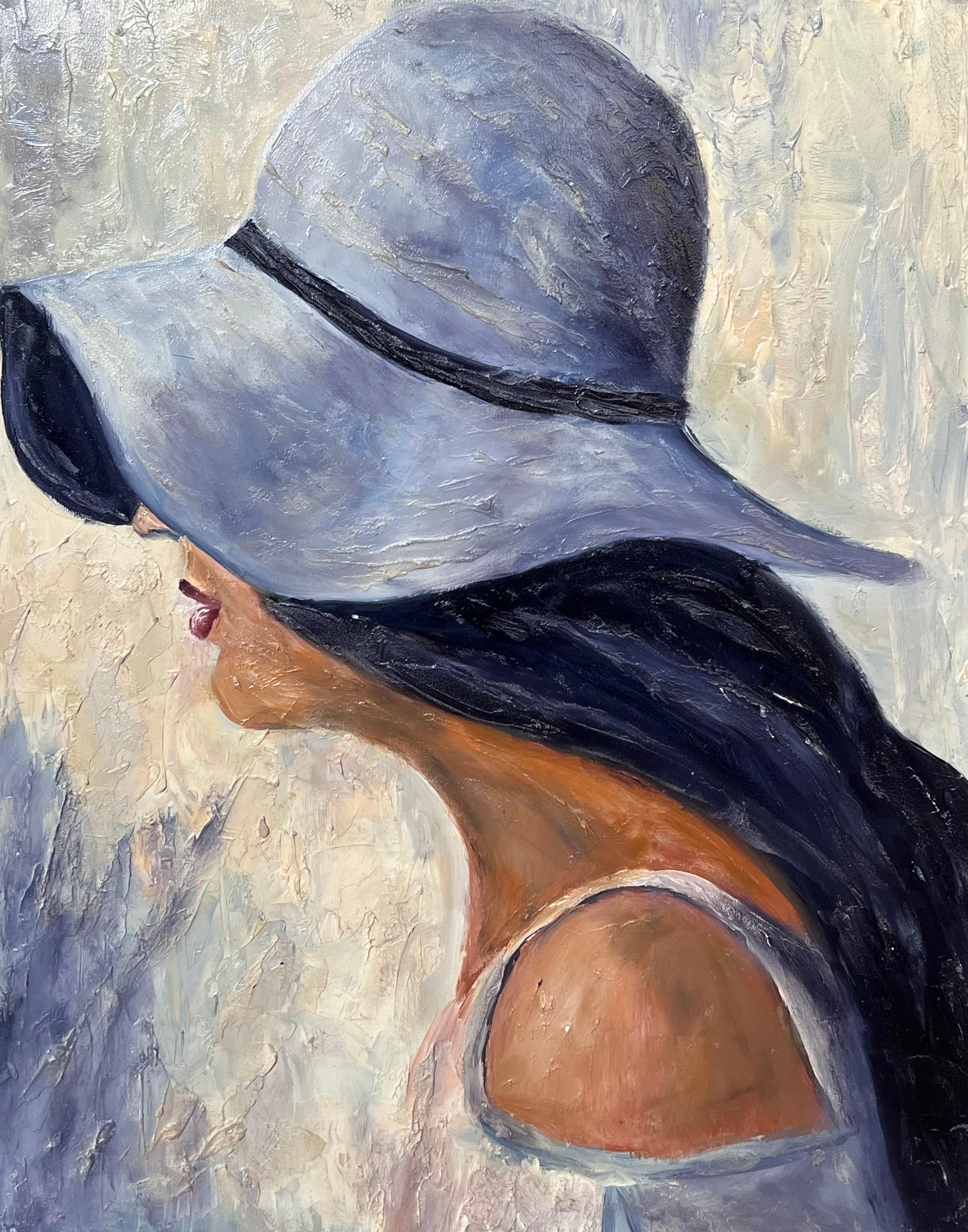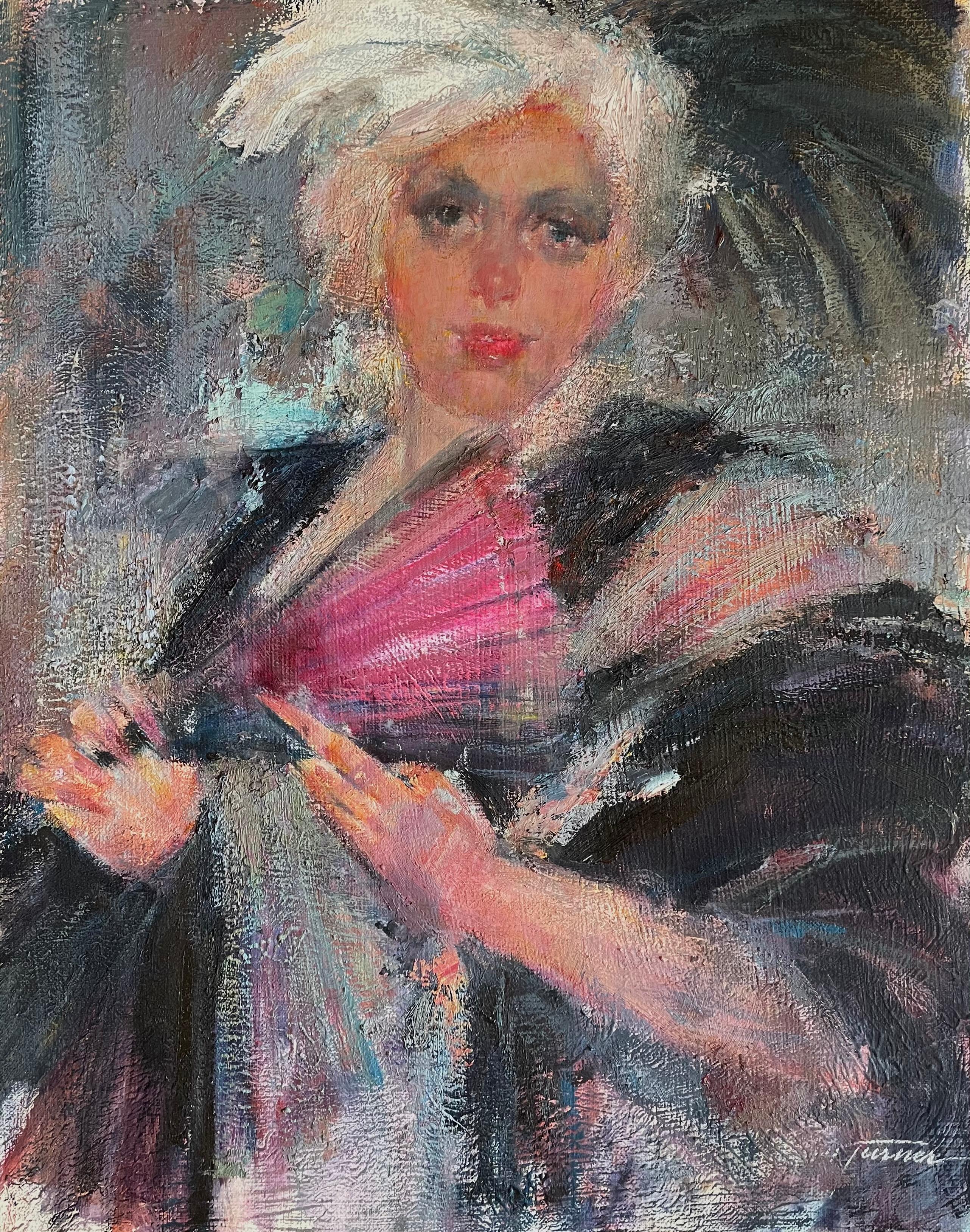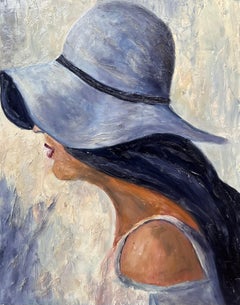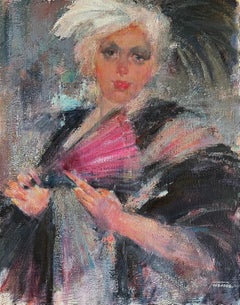Items Similar to Woman in profile with fan oil on board painting
Want more images or videos?
Request additional images or videos from the seller
1 of 12
Gumersindo VilaWoman in profile with fan oil on board paintingc.2000
c.2000
$839.43
$1,199.1830% Off
£624.45
£892.0730% Off
€700
€1,00030% Off
CA$1,149.46
CA$1,642.0930% Off
A$1,278.04
A$1,825.7830% Off
CHF 667.32
CHF 953.3230% Off
MX$15,556.90
MX$22,224.1430% Off
NOK 8,514.76
NOK 12,163.9430% Off
SEK 7,977.92
SEK 11,397.0330% Off
DKK 5,328.71
DKK 7,612.4530% Off
Shipping
Retrieving quote...The 1stDibs Promise:
Authenticity Guarantee,
Money-Back Guarantee,
24-Hour Cancellation
About the Item
Frame size 71x62 cm.
Biography of Gumersindo Vila
Full Name: Gumersindo Vila
Date of Birth: April 14, 1950
Place of Birth: Santiago de Compostela, Spain
Nationality: Spanish
Artistic Style: Contemporary Realism, Surrealism, Figurative Painting
Academic Background: School of Fine Arts of San Carlos, Valencia, 1968-1974
Early Life and Beginnings
Gumersindo Vila was born in Santiago de Compostela in 1950, into a family deeply connected to Galician cultural traditions. From a young age, he showed an exceptional talent for drawing, particularly influenced by the natural landscapes of Galicia and the popular legends his grandparents would tell him. In his childhood, the mountains and forests of his homeland, along with the ancient churches and medieval architecture, left an indelible mark on his imagination and would later influence his artwork.
At the age of 18, Vila moved to Valencia to continue his academic studies, enrolling at the School of Fine Arts of San Carlos. It was here that his passion for figurative painting and realism began to take shape. During this period, he also became intrigued by surrealism and 20th-century avant-garde movements, studying painters such as Salvador Dalí, René Magritte, and the great Renaissance masters.
Academic Training and Early Works
During his time in Valencia, Gumersindo Vila stood out as an exceptional student. His professors quickly recognized his mastery of drawing and his ability to create canvas compositions with an almost cinematic atmosphere, which would later become his distinctive signature. Although his training was grounded in classical techniques, Vila was always drawn to the boundaries of visual reality and the distortion of perception, influences that would lead him to explore surrealism while maintaining a realist approach to his technique.
Upon graduating in 1974, Vila returned to Galicia, where he dedicated himself to painting professionally. At first, his work was very introspective, focusing on the landscapes of his native region, often imbuing them with an emotional depth that bordered on the dreamlike. It was during this period that he began experimenting with integrating surreal elements into his realist style, creating compositions where nature transformed into a psychological space filled with symbols and metaphors.
Professional Career
In the 1980s, Gumersindo Vila began exhibiting his work in galleries in Madrid and Barcelona. His first solo exhibition, titled "Landscapes of the Soul", was held in 1983 at the Luis Adelantado Gallery in Valencia, marking a turning point in his career. In this exhibition, Vila presented a series of paintings that combined rural Galician landscapes with surreal elements, such as figures emerging from the ground or clouds forming human faces. Both the public and critics were fascinated by his ability to integrate human emotion into the simplest, most everyday scenes.
Throughout the 1990s, his work evolved toward an even more introspective style. He began combining traditional painting with experimental techniques, such as the use of mixed media on canvas and incorporating three-dimensional objects into some of his works. During this period, he also began exploring portraiture, focusing on capturing the deep and complex emotions of his subjects, often using light and color to reflect the inner soul.
In 1995, Gumersindo participated in the exhibition "Portraiture in Contemporary Painting", organized by the Prado Museum, where his unique style was praised for both its technical precision and its ability to create an immersive atmosphere that invited the viewer into the subject’s mind.
Style and Themes
Gumersindo Vila is known for his ability to blend the most precise realism with a dreamlike, surreal atmosphere that challenges the viewer’s perception of reality. His works are a fusion of carefully detailed visual elements that, while representing everyday scenes, always convey a sense of unreality—as if the viewer is observing the world through a distorted lens or from an alternate dimension.
Regarding the themes of his work, Vila has consistently explored the human condition, memory, and the psyche. His portraits do not merely aim to capture the external appearance of his subjects but also their deepest emotions, often reflected in the surreal backgrounds that surround them. On the other hand, his landscapes are filled with symbolism: trees that seem to spiral, clouds merging with human figures, and settings that, while recognizable, seem to be outside the realm of everyday reality.
Another recurring theme in Vila's work is the duality between life and death, reality and dreams, the physical and the spiritual. His paintings often depict scenes in which the boundaries between these worlds blur, as if they were in a constant conversation between the human being and the immaterial.
Recognition and Legacy
Throughout his career, Gumersindo Vila has received several awards, including the National Painting Prize in 1992 and the Contemporary Art Critic's Prize in 2001. His work has been recognized both in Spain and internationally, and has been the subject of solo exhibitions at major institutions such as the Museo de Arte Contemporáneo in Madrid and the National Art Gallery in Buenos Aires.
In 2005, the Museum of Modern Art of Galicia held a retrospective exhibition of his work, showcasing the evolution of his style over the decades. The exhibition was a resounding success, solidifying Vila as one of the most important painters in contemporary Spanish art.
In addition to his artistic production, Gumersindo Vila has been an advocate for figurative painting in an era dominated by the rise of conceptual art. Over the years, he has given lectures and workshops, promoting the importance of technique and critical thinking in the creative process.
Conclusion
Gumersindo Vila is a painter whose work transcends the boundaries of realism, uniquely blending precise detail with surrealist atmosphere. Through his style, he has brought to life a world where human perception and the dreamlike coexist, inviting viewers to reflect on the mysteries of the mind and nature. His legacy as one of the great figures of contemporary realism in Spain remains significant, and his work continues to inspire new generations of artists who seek to explore the possibilities of figurative painting in the modern age.
About the Seller
5.0
Platinum Seller
Premium sellers with a 4.7+ rating and 24-hour response times
Established in 2007
1stDibs seller since 2019
441 sales on 1stDibs
Typical response time: 1 hour
- ShippingRetrieving quote...Shipping from: sitges, Spain
- Return Policy
Authenticity Guarantee
In the unlikely event there’s an issue with an item’s authenticity, contact us within 1 year for a full refund. DetailsMoney-Back Guarantee
If your item is not as described, is damaged in transit, or does not arrive, contact us within 7 days for a full refund. Details24-Hour Cancellation
You have a 24-hour grace period in which to reconsider your purchase, with no questions asked.Vetted Professional Sellers
Our world-class sellers must adhere to strict standards for service and quality, maintaining the integrity of our listings.Price-Match Guarantee
If you find that a seller listed the same item for a lower price elsewhere, we’ll match it.Trusted Global Delivery
Our best-in-class carrier network provides specialized shipping options worldwide, including custom delivery.More From This Seller
View AllWoman with paipai fan oil on canvas painting portrait
By Joan Palet
Located in Barcelona, Barcelona
Joan Palet (1911 - 1996) - Female figure - Oil on canvas
Oil measures 81x65 cm.
Frameless.
Joan Palet was born in Barcelona on March 28, 1911 in a family of sculptors and wood carve...
Category
1970s Impressionist Portrait Paintings
Materials
Canvas, Oil
woman with hat in profile oil on canvas painting portrait
Located in Barcelona, Barcelona
Alexandre Siches (1921-2009) - Woman in profile - Oil on canvas
Oil measures 73x54 cm.
Frameless.
Alexandre Siches Piera (1921-2009)
Catalan painter with an innate capacity for dra...
Category
1980s Impressionist Portrait Paintings
Materials
Oil, Canvas
$1,439 Sale Price
25% Off
woman in profile oil on canvas painting portrait
Located in Barcelona, Barcelona
Alexandre Siches (1921-2009) - Woman in profile - Oil on canvas
Oil measures 35x27 cm.
Frameless.
Alexandre Siches Piera (1921-2009)
Catalan painter with an innate capacity for dra...
Category
1960s Impressionist Portrait Paintings
Materials
Canvas, Oil
Girl in profile oil on canvas painting
Located in Barcelona, Barcelona
José Miret Aleu (1912-1999) - Girl in profile - Oil on canvas
Oil measurements 41x33 cm.
Frame size 50x42 cm.
Painter born in Barcelona in 1912. He studied drawing at the Baixas Aca...
Category
1940s Impressionist Portrait Paintings
Materials
Oil, Canvas
$1,019 Sale Price
43% Off
Woman with fan mixed media painting
By Jordi Curos
Located in Barcelona, Barcelona
Jordi Curós Ventura (1930-2007) - Woman
Mixed technique on canvas board.
Work measurements 35x27 cm.
Frame size 40x32 cm.
Jordi Curós Ventura (Olot, Girona, March 4, 1930) is a Span...
Category
1970s Fauvist Portrait Paintings
Materials
Mixed Media
Woman with fan mixed media painting
By Jordi Curos
Located in Barcelona, Barcelona
Jordi Curós Ventura (1930-2007) - Woman
Mixed technique on canvas board.
Work measurements 46x38 cm.
Frame size 51x43 cm.
Jordi Curós Ventura (Olot, Girona, March 4, 1930) is a Span...
Category
1970s Fauvist Portrait Paintings
Materials
Mixed Media
$299 Sale Price
37% Off
You May Also Like
Fan. Portrait of a girl, impressionism, vertical, beauty, Japan
Located in Oslo, NO
This elegant vertical composition is an ode to femininity, mystery and oriental aesthetics. The graceful figure of a young woman in a kimono opens a fan with a refined gesture - a sy...
Category
2010s Post-Impressionist Figurative Paintings
Materials
Canvas, Oil
20th Century French Oil Painting Profile Portrait Lady in Lilac Hat
Located in Cirencester, Gloucestershire
Portrait of a Lady in a Lilac Hat
French, late 20th century
oil on board, unframed
board: 16 x 13 inches
Provenance: private collection, France
Condition: very good condition
For m...
Category
Late 20th Century French School Portrait Paintings
Materials
Oil
Spring Woman, Portrait, Original Oil Painting, Handmade Artwork, One of a Kind
Located in Granada Hills, CA
Artist: Ashot Muradyan
Work: Original Painting, Handmade Artwork, One of a Kind
Medium: Oil on Linen
Year: 2024
Style: Impressionism,
Subject: Spring Woman
Size: 23.5" x 19.5" x 0....
Category
2010s Impressionist Portrait Paintings
Materials
Canvas, Oil
LADY WITH PICK FAN
Located in Los Angeles, CA
Biography from the niece of the artist from during his lifetime. Paintings acquired from the artist.s estate.
Max Turner
1925 - 2019
Max Lamar Turner Painter, Sculptor, Teacher and Author.
Max Turner was born in Omaha, Nebraska on July 28, 1925. His father was Lance Howard Turner and his mother Mary Irene Turner. In 1927, his family moved to Bingham Canyon, Utah where Max's father extracted copper from a creek that he had diverted to pass through his garage. The town was located in a narrow canyon on the eastern face of the Oquirrh Mountains. In 1938, when Max was 13, his family moved to Midvale, Utah. After completing high school, Max went to work laying rail until he was inducted into the U.S. Navy to serve during W.W. II.
There he took an aptitude test and was initially assigned to the medical corp., later transferring to the dental unit. Max was stationed at Port Hueneme, Ventura County, California through the end of the war. When he was discharged in 1946, he remained in Southern California, living in the Los Angeles area. He met a man named Larry Torres and they formed a partnership to do silk screen work primarily for the Colby Poster Printing Company. This lasted about 10 years until the Colby building caught fire and burned down. In 1958, Max began working for Slade Novelty company that made doll parts using a product called plastisol. A year later, Max began producing plastic parts through his own business. One day, a couple of kids brought in a shrunken skull they had made and asked Max if he could reproduce it. Max said he could and he looked around for a business to work with for this task. He ultimately decided he could create his own machine shop to make molds. As a result, Max purchased a lathe, drill press, grinder and other tools to create his own machine shop and went into business making molds. He built a clientele and in 1973, he moved his machine shop to Glendale, California.
Painter, Sculptor, Teacher and Author:
Max recalls the day when his interest in art took a new direction. He happened to be in a paint store to purchase some supplies when he saw a card posted on a wall that read, "Come paint with Connie Marlo". Max had been interested in art since his youth and he was frequently impressed with paintings displayed by local artists at various community events.
Consequently, he decided to go to Connie's Saturday morning art class at a studio on North La Brea Avenue (between Sunset and Hollywood) in Los Angeles. But, as fate would have it, he immediately took a detour from this class when he found a piece of paper on the floor of the studio referencing another art class dealing with compositions, patterns, rhythms and color harmony. The instructor's name was Hal Reed, a former art student of the Russian/American Master, Nicolai Fechin. Hal owned the building (previously the Will Foster Studio) and had founded the Art League of Los Angeles. When Max found Hal, he asked Hal if he could join his class. Hal said "No, the class was full" but he said Max could monitor the class in the back of the classroom. Max took him up on the offer and began observing the weekly class.
During the class, Hal told his students that they should practice what they were learning by going to "live model" classes. Max began attending these classes where he learned how to draw figures. After a few months, Hal and Max became good friends. Hal was so impressed with Max's work that he offered Max the opportunity to teach at another location that Hal was opening in the San Fernando Valley. Max accepted the offer and began teaching his own art class. For Max, it was a quick jump from learning to teaching. Max then found that several of his students had to commute to his art class from the west end of the "Valley". To better serve this group of students, Max decided to relocate to another studio in Calabasas.
Max continued teaching, and at this time he was producing very impressive portraits, both oil paintings and charcoal drawings from live models (Max never worked from photos). Max demonstrated real talent, and the style of his drawings and paintings were being compared to those of Nicolai Fechin. And, like Fechin, Max also had an interest in sculpting. One day, Max decided to design and cast a bronze owl sculpture to put in his Calabasas Fine Art Gallery. Later, someone approached Max when he was at the foundry and asked him about his success selling the owl sculpture. The individual who asked this question was convinced that there was a broader market for these sculptures and he ordered a dozen of the owl sculptures from Max. This encouraged Max to do more castings. Some of the new castings were antique sculptures he found and reproduced. As this new business grew, he decided to establish his own foundry, employing up to 15 workers. The business continued for many years, up until the late 1990's when Max got tired of the foundry business and sold it.
Max, who was now in his 70's, decided to move on to his next venture as an artist, dedicating himself to doing the actual sculpting of original art. He loved the creativity of sculpting and he had his sculptures cast at local foundries, ironically the same ones that used to be his competition. Max was now fully engaged in his new artistic direction and, over time, he produced a large body of work. He created very impressive sculptures, including about 100 full-size sculptures. He sold some of these to high-end clientele, the Foundry at SLS Las Vegas, and to Hollywood studios.
Even though Max now seemed to be totally in his element, he somehow also found time to continue to teach painting classes at the California Art Institute in Westlake Village in Los Angeles. At the institute, he specialized in figure work. Max continued to draw, paint and teach, but he says he stopped sculpting when he turned 90.
Max produced four books showcasing his drawings and paintings. The first is "Faces, The Drawings of Max Turner", copyright 2000, that showcases nearly 100 of his portrait drawings. Within the "Acknowledgements" section, he lists Hal Reed and Joseph Nordmann, two former students of Nicolai Fechin.
In 2006, Max produced his second book titled "Figures and Faces", reflecting not only portraits but also figure drawings and paintings. It is a wonderful book of Max's work, but it is currently difficult to find. The third book is titled "Faces 2, The Paintings and Drawings of Max Turner", copyright 2009, which includes 75 portrait paintings and drawings. In the "Preface" of this book, Max describes growing up in a small and isolated mining town during the Great Depression. He states that as a kid, he had little exposure of any culture or view of what the rest of the world was like. His neighbor was the trash collector and Max would sometimes go through his truck looking for anything of value. Among other things, he found magazines like Cosmopolitan, Good Housekeeping and Red Book, with covers that frequently showed drawings or paintings of faces. Max states that these images were the very first source of inspiration for him. He says that he began looking more carefully at people's faces and if they had character, he would draw them. By drawing them, Max says that he was making them part of his world, his world of "Faces".
In 2018, Max published his newest book showcasing his drawings and paintings. It is titled "Max Turner's Figure Sketches". This softbound book includes 76 pages and over 120 drawings and paintings. In the Introduction, Max explains "I have found that when approaching the figure, one should begin with the gesture. After having captured the essence or feeling of the pose, one can then proceed to build on it." The figure sketches in this wonderful book reflect a Master's work that consistently captures the "gesture"-showing the emotion, movement and expression.
Two more books are on the horizon for Max, both dealing with his passion for sculpting. His first, "The Sculpture of Max Turner" is a compilation of his commercial and noncommercial pieces throughout his career. The second, "Terra Cotta Sculpture by Max Turner" is a complete collection of figures done at the California Art Institute. These much anticipated books should be out later in 2018.
Max now considers himself primarily a sculptor. But others in the art world are more than impressed with his drawings and paintings as well. His portraits are often described as having a Fechin-esque appearance, referring to the style of Nicolai Fechin. When Max observed those first art classes given by Hal Reed, it should be noted that Hal had previously been a student of the Russian/American Master Nicolai Fechin in the early to mid-1950's. In fact, Hal was a student in the last art class that Fechin taught before he unexpectedly died in 1955. Hal was so strongly influenced by Fechin that he later produced two 30-minute art instruction videos as part his Art Video Productions wherein he specifically described Fechin techniques that he learned in Fechin's class. The Fechin style and techniques were in play when Max later met Hal. Over the years, many of Max's art students, art collectors, gallery owners, as well as the Director of the Monterey Museum of Art have commented on the Fechin-esque qualities of Max's wonderful charcoal drawings and paintings. So, while Max may consider himself primarily a sculptor, his drawings and paintings are also impressive and very much sought after.
When Nicolai Fechin died in 1955, three of the nine students in his last art class became life-long friends. Max subsequently became friends with not only Hal Reed, but also with prior Fechin students Joseph Nordmann and Albert Londraville...
Category
1990s Modern Figurative Paintings
Materials
Canvas, Oil
$450 Sale Price
64% Off
Elegance – Oil Portrait of a Woman, Spanish Romantic Figurative Art
Located in London, GB
This captivating oil painting by Luís Muntané Muns exemplifies the artist’s mastery in figurative art, portraiture, and classical elegance. Renowned for his evocative depictions of finely dressed women, Muns presents a young woman in an opulent, multi-layered gown, her delicate posture exuding both grace and introspection. The artist’s soft yet expressive brushwork enhances the flowing fabric, creating a striking contrast against the dark, atmospheric background.
Muns, born in 1899 in Mataró, Spain, studied under José Mongrell...
Category
Mid-20th Century Romantic Portrait Paintings
Materials
Oil, Panel
Postmodern/Chinoiserie Framed and Signed Oil Painting of Lady With Fan
Located in Delray Beach, FL
Incredible Patrick Nagel style vintage postmodern/chinoiserie oil painting. Displayed in a pink frame, subject is a woman with black hair in a...
Category
Vintage 1980s Chinoiserie Paintings
Materials
Canvas, Wood, Paint
More Ways To Browse
Fan Light
Hand Painted Hand Fans
Oil Portrait Spanish Woman
Rene Magritte Painting
Salvador Dali Woman
Salvador Dali 1968
Dali Time And Space
Santiago De Compostela
Magritte Clouds
Crime And Punishment
William Frith
Charlize Theron
Jay Jacobs
Vintage Merry Go Round Horse
17th Century Dutch Jewelry
Coronation Robe
Duke Of Somerset
Gina Palmerin



